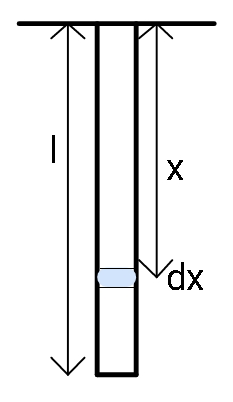
A rod of uniform cross-sectional area A and length L has a weight W. It is suspended vertically from a fixed support. If the material of the rod is homogeneous and its modulus of elasticity is, I then determine the total elongation produced in the rod due to its own weight.
Answer
576k+ views
Hint: Start by writing the formula for elastic modulus. Find out the elongation for a small element of the road (dx). Integrate on the whole length of the rod to find out the required elongation of the entire rod.
Formula used:
Young’s modulus for elongation of a rod of length l when a force F (external) is acting on it is given as:
$Y = \dfrac{F/A}{\Delta l/l}$.
Complete step-by-step answer:
We no that modulus of elasticity is given as the ratio of stress acting (linearly) on the rod and the strain which produces elongation in the rod;
$Y = \dfrac{stress}{strain}$
Stress is nothing but the force per unit area acting on the body and strain is the ratio of change created in the length upon original length, so;
$Y = \dfrac{F/A}{\Delta l/l}$;
Here, A will be the area of the cross section of the rod and $\Delta l$ will be the elongation i.e., the difference of final length and initial length l.
The elongation can be written as: $ \Delta l = \dfrac{l(F/A)}{I}$ ; where we replaced Y with I (given).
For an elongation of any smaller section dx of the rod we can write: $d(\Delta l) = \dfrac{F}{AI} dx$ ; here, we just used dx in place of l.

The force acting on this small element dx will be due to the rod weight below it.
Therefore, $F = \dfrac{W}{l} (l-x)$ ;
where, W/l is for uniform distribution of weight. Total elongation for the entire rod can be written as:
$\Delta l = \dfrac{W}{lAI} \int_{0}^{l} (l-x) dx = \dfrac{W}{lAI} \left(lx - \dfrac{x^2}{2} \right) \Bigg|_{0}^{l}$ .
This must give us the required total elongation as: $\Delta l = \dfrac{Wl}{2AI} $
Note: The integration was performed from zero to length l, by considering zero as the point where the rod is attached (or hanged). The distance x of the element dx was also measured from the point where the road was attached.
Formula used:
Young’s modulus for elongation of a rod of length l when a force F (external) is acting on it is given as:
$Y = \dfrac{F/A}{\Delta l/l}$.
Complete step-by-step answer:
We no that modulus of elasticity is given as the ratio of stress acting (linearly) on the rod and the strain which produces elongation in the rod;
$Y = \dfrac{stress}{strain}$
Stress is nothing but the force per unit area acting on the body and strain is the ratio of change created in the length upon original length, so;
$Y = \dfrac{F/A}{\Delta l/l}$;
Here, A will be the area of the cross section of the rod and $\Delta l$ will be the elongation i.e., the difference of final length and initial length l.
The elongation can be written as: $ \Delta l = \dfrac{l(F/A)}{I}$ ; where we replaced Y with I (given).
For an elongation of any smaller section dx of the rod we can write: $d(\Delta l) = \dfrac{F}{AI} dx$ ; here, we just used dx in place of l.

The force acting on this small element dx will be due to the rod weight below it.
Therefore, $F = \dfrac{W}{l} (l-x)$ ;
where, W/l is for uniform distribution of weight. Total elongation for the entire rod can be written as:
$\Delta l = \dfrac{W}{lAI} \int_{0}^{l} (l-x) dx = \dfrac{W}{lAI} \left(lx - \dfrac{x^2}{2} \right) \Bigg|_{0}^{l}$ .
This must give us the required total elongation as: $\Delta l = \dfrac{Wl}{2AI} $
Note: The integration was performed from zero to length l, by considering zero as the point where the rod is attached (or hanged). The distance x of the element dx was also measured from the point where the road was attached.
Recently Updated Pages
Why are manures considered better than fertilizers class 11 biology CBSE

Find the coordinates of the midpoint of the line segment class 11 maths CBSE

Distinguish between static friction limiting friction class 11 physics CBSE

The Chairman of the constituent Assembly was A Jawaharlal class 11 social science CBSE

The first National Commission on Labour NCL submitted class 11 social science CBSE

Number of all subshell of n + l 7 is A 4 B 5 C 6 D class 11 chemistry CBSE

Trending doubts
Differentiate between an exothermic and an endothermic class 11 chemistry CBSE

10 examples of friction in our daily life

One Metric ton is equal to kg A 10000 B 1000 C 100 class 11 physics CBSE

Difference Between Prokaryotic Cells and Eukaryotic Cells

1 Quintal is equal to a 110 kg b 10 kg c 100kg d 1000 class 11 physics CBSE

State the laws of reflection of light




